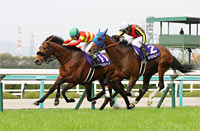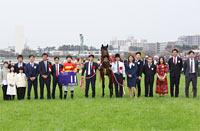Osaka Hai (G1) - Data Analysis
Middle-distance champion decider of the spring season
The Osaka Hai has earned a reputation for bringing together top runners since it was still contested as a G2 race, but it has attracted runners of an even higher caliber since its status was upgraded to G1 in 2017. The race has seen favorite runners snatch the victory in line with expectations but also delivered major upsets, making it an exciting contest from a betting standpoint. Let’s now look at some trends in this race based on data for the seven years since its upgrade to G1 status.
Focus on four-year-olds and five-year-olds
Of the 21 Top 3 finishers in the last seven years, 20 were either four-year-olds or five-year-olds. Within this group, four-year-olds and five-year-olds that had experience of winning a G1 race achieved performance of [3-5-4-14], with a Top 2 ratio of over 30% and a Top 3 ratio of nearly 50%. Conversely, the only runner aged 6 or above that finished in the Top 3 was 2017 runner-up Staphanos, so the data suggest we can lower our expectations of such runners. [Table 1]
[Table 1] Performance by age (last seven years)
| Age |
Performance
[1st-2nd-3rd-4th or lower] |
Win ratio |
Top 2 ratio |
Top 3 ratio |
| 4 |
2-3-5-22 |
6.3% |
15.6% |
31.3% |
| 5 |
5-3-2-28 |
13.2% |
21.1% |
26.3% |
| 6 or above |
0-1-0-30 |
0% |
3.2% |
3.2% |
High success ratios for fillies and mares
Although few in overall number over the last seven years, fillies and mares have achieved high success ratios in the race. They finished consistently in the Top 2 in the four years from 2020 to 2023. In particular, fillies and mares that were backed as 4th favorite or higher delivered performance of [2-3-0-2], with a Top 2 ratio of 71.4%. If fillies and mares are highly favored, we should consider them as potential contenders. [Table 2]
[Table 2] Performance by gender (last seven years)
Gender |
Performance
[1st-2nd-3rd-4th or lower] |
Win ratio |
Top 2 ratio |
Top 3 ratio |
| Colts and geldings |
5-4-7-73 |
5.6% |
10.1% |
18.0% |
| Fillies and mares |
2-3-0-7 |
16.7% |
41.7% |
41.7% |
Horses with no change in jockey have the edge
Many runners target the Osaka Hai as a milestone race for the spring season, but success ratios have diverged widely between horses that were ridden by the same jockey as in the previous race and those with a change of jockey from the previous race. While both groups had roughly the same number of entrants, horses ridden by the same jockey as in the previous race achieved a Top 2 ratio that was nearly four times higher and a Top 3 ratio that was nearly three times higher than those with a change of jockey from the previous race, so we should focus on the former group. [Table 3]
[Table 3] Performance by jockey (last seven years)
| Jockey |
Performance
[1st-2nd-3rd-4th or lower] |
Win ratio |
Top 2 ratio |
Top 3 ratio |
| Same jockey as in previous race |
6-5-4-34 |
12.2% |
22.4% |
30.6% |
| Different jockey |
1-2-3-46 |
1.9% |
5.8% |
11.5% |
High likelihood of success for runners coming from a G1 or G2 race
Runners that had contested a G1 or G2 race last time out enjoyed high success ratios over the last seven years. Especially worthy of note within this group were runners coming from a G2 race, particularly those that had finished in the Top 5 of the Kinko Sho or Nakayama Kinen. Runners in this group achieved performance of [4-2-2-17]. We should also keep in mind that several such runners performed well despite low favoritism, such as 2022 winner Potager (8th favorite) and 2019 winner Al Ain (9th favorite). [Table 4]
[Table 4] Performance by previous race (last seven years)
| Previous race |
Performance
[1st-2nd-3rd-4th or lower] |
Win ratio |
Top 2 ratio |
Top 3 ratio |
| G1 |
1-2-1-10 |
7.1% |
21.4% |
28.6% |
| G2 |
4-5-5-55 |
5.8% |
13.0% |
20.3% |
| G3 |
1-0-1-10 |
8.3% |
8.3% |
16.7% |
| Open-class race |
0-0-0-1 |
0% |
0% |
0% |
| 3-win class |
0-0-0-1 |
0% |
0% |
0% |
| Overseas G1 race |
1-0-0-3 |
25.0% |
25.0% |
25.0% |
Seek out the winner!
Focus on front runners
All seven winners since the Osaka Hai was upgraded to G1 status were positioned 5th or higher when passing the 4th corner in the race. Incidentally, five of the seven winners had also been positioned 4th or higher when passing the 4th corner in their previous race. Jack d’Or and Potager, who did not fall into this category, had similarly turned in strong performance in previous races where they led the pack, so we should select front runners as potential win contenders. [Table 5]
[Table 5] Winners’ position when passing the 4th corner in the Osaka Hai, and position when passing the 4th corner in the previous race (last seven years)
| Year |
Winner |
Position when passing 4th corner |
Position when passing 4th
corner in previous race |
| 2017 |
Kitasan Black |
2nd |
2nd |
| 2018 |
Suave Richard |
Leader |
2nd |
| 2019 |
Al Ain |
4th |
3rd |
| 2020 |
Lucky Lilac |
5th |
4th |
| 2021 |
Lei Papale |
Leader |
Leader |
| 2022 |
Potager |
4th |
12th |
| 2023 |
Jack d’Or |
Leader |
Previous race contested overseas |
(Yodohito Himezono)
|



















